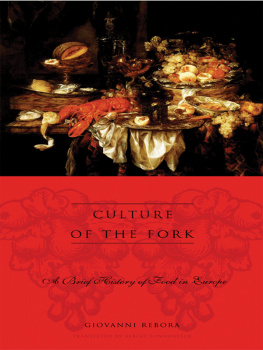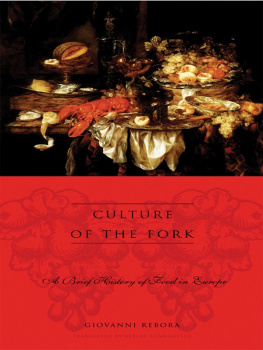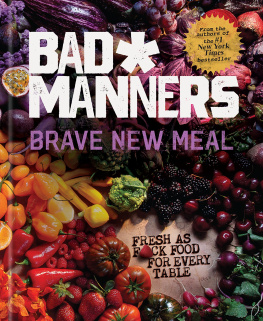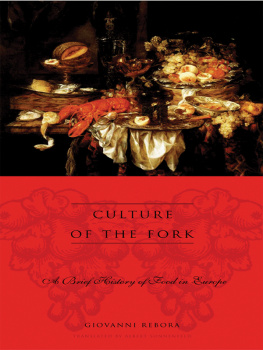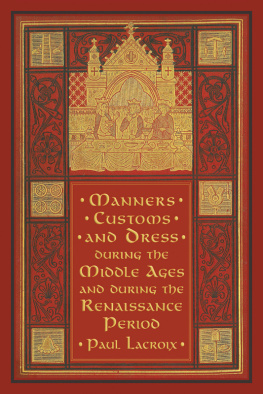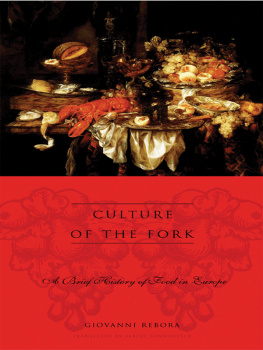CULTURE OF
THE FORK
ARTS AND TRADITIONS OF THE TABLE
ARTS AND TRADITIONS OF THE TABLE
Perspectives on Culinary History
Albert Sonnenfeld, series editor
Salt: Grain of Life
Pierre Laszlo
TRANSLATED BY MARY BETH MADER

COLUMBIA UNIVERSITY PRESS
Publishers Since 1893
New York Chichester, West Sussex
cup.columbia.edu
Translation Columbia University Press 2001.
La civilt della forchetta 1998 Gius. Laterza & Figli Spa,
Roma-Bari. English language edition arranged through the mediation of Eulama Literary Agency.
E-ISBN 978-0-231-51845-1
Library of Congress Cataloging-in-Publication Data
Culture of the fork : a brief history of food in Europe /
by Giovanni Rebora ; translated by Albert Sonnenfeld.
p. cm.
Includes bibliographical references and index.
ISBN 0-231-12150-4 (cloth)
1. Gastronomy. 2. Food habitsEurope. 3. Cookery, European.
TX641 .C535 2001
394.1094dc21 2001032450
A Columbia University Press E-book.
CUP would be pleased to hear about your reading experience with this e-book at .

As translator from the Italian of this savory of culinary history, I was faced with sixty specifically named Italian words for pork or beef sausage and in English found only sausage and salami. An infinity of constellations of untranslatable pasta shapes further impeded my Promethean climb. My recompense was a keener historical awareness and appreciation of the gastronomic bounty of Bella Italia.
As series editor of Arts and Traditions of the Table, I am delighted to share this readable, insightful, and delightful history by Giovanni Rebora with a broad readership of nonspecialist food-lovers, gourmets, gourmands, and Italophiles.
I had always been convinced that frequent famines marked Europes Early Modern or postmedieval period. In fact, for centuries, the average Italian peasant had several pounds of meat available to him each week at very modest cost. Why? Because the demand for calfskin and ox- and cowhides for saddles, wineskins, riding gear, and so on, greatly exceeded the supply. So to meet this demand, more and more cattle were bred, creating an oversupply of meat and lowering its price, but also inflating the cost of feed and pastureland.
The Catholic Churchs rigid enforcement of lean [meatless] days added to the meat surplus, while fish and other authorized foods escalated in price. Cattle went to market on its own legs; fish had to be transported, and quickly, to avoid spoilage. Large fish were caught on line, not in nets, and were too expensive for any but the nobility and merchants.
To those who thought the fork an invention of Renaissance nobility to ensure courtly manners, I say, Think again!
Among the fascinating array of revealing insights dispensed by Giovanni Rebora in this readable, concise, chatty book is documentation that the single prong or spit evolved into a utensil resembling our modern fork (or digits of the diners hand) for very practical reasons. As the Euclidean geometry of pasta shapes developed (and that was long before Marco Polos famous voyage to China), the slippery strings of spaghettini either burned or slipped elusively through the diners fingers. Hence the ingenious fork, which allowed one both to spear and to twirl.
Later, in some devout circles, the fork was considered a decadent extravagance or an excess of precious refinement. Even in 2001, the great three-star Milanese chef Gualtiero Marchesi is hard at work developing a new model for a pasta fork.
In keeping with his belief that practical economic needs motivate gastronomic progress and culinary technology, Rebora reminds us that plates were a creation of the Early Modern. What began as a slab of bread onto which portions of victuals were placed (the first pizza, one might say!) became, thanks to renewal of ceramics neglected since the Roman Empire, an autonomous plate. And of course pizza and the pitta of the eastern Mediterranean are etymologically and culinarily twin solutions to the same problem of how to serve food at the table.
Every chapter of this informal rendering of culinary history (and the chapters are delightfully concise) yields new perspectives on foods, class structures, topography, manners, gastropolitics and market conditions in postmedieval Europe, from south to north, with a strong Mediterranean emphasis.
From what we call the Early Modern to the Modern is but a step, and Giovanni Rebora guides us with a steady and friendly hand from past to present.
ALBERT SONNENFELD

The Early Modern era begins at the end of the fifteenth century. We historians always say this, in respectful tribute to academic convention. But however arbitrary such generalizations may be, the fall of Constantinople to Mohammed II on May 29, 1453, signaled the end of a world.
The discovery of America on October 12, 1492, only a few months after the Christian reconquest of Granada (in April) and the expulsion of the last Islamic king from the Iberian Peninsula, was another memorable event, one that also marked the beginning (albeit with many delays) of a new era in culinary history, whether in Europe, America, Africa, or Asia.
Meanwhile, in Great Britain, the end of the Hundred Years War (fought on French soil) and the end of the War of the Roses allowed the island kingdom to structure itself politically, free at last of longstanding ties to the Continental landmass.
In France, Burgundy (long allied with the English against the ragtag armies of Joan of Arc) lost its independence with the reign of Charles the Bold. But the count of Flanders, adorned with the Order of the Golden Fleece, continued the somewhat archaic splendor of the waning Middle Ages: a little of this culture survived in the Piedmont, in the dukedom of Saluzzo.
The heir to the thrones of Castille, Aragon, and Navarre, Charles I of Hapsburg, later to become Emperor Charles V, was born in Flanders. So a little of Flemish culture migrated to Spain and vice versa: flamenco survived in Andalusia, the bodegas in Flanders.
If Venice ultimately expended far too much energy and treasure defending its colonial possessions in Greece, Genoa, sagely and in stark contrast, very slowly withdrew its investments from the Orient without resorting to ruinously expensive wars. The Genoese went to Andalusia and the former Kingdom of Granada to take over from the Arabs and Jews who had been chased out by the hostile policies imposed following the Reconquest. They were solidly ensconced in Seville, as well as in the Kingdom of Granada, by the middle of the thirteenth century, and at the end of the fifteenth, of the 500 merchants in Seville, the 350 richest were from Genoa.
In Italy, in the fifteenth century, there developed the splendid cultural transformations we call the Renaissance. With the exception of the Kingdom of Naples, the Trentino, the Piedmont near Turin, and the duchy of Saluzzo (and perhaps a few tiny enclaves like the duchy of Finale), Italy was governed by Italian lords and princes, by Italian oligarchies as in Venice, Genoa, and Lucca, or else by the pope, who passed out fiefdoms to his nephews. All these lords, who were often mercenary captains of noble extraction but also bankers and merchants (in addition to the aforementioned papal relatives), enjoyed fabulous wealth. Moreover, these moneyed classes, thanks to arranged marriages with Italian and foreign nobility or perhaps in return for generous loans made to royalty, often acquired noble and feudal titles.
Next page
